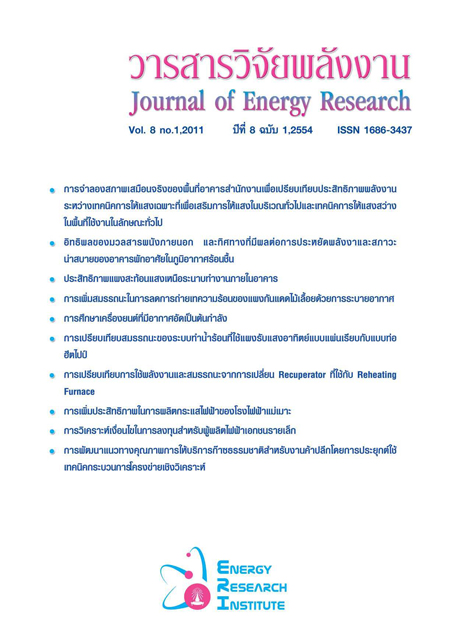การศึกษาเครื่องยนต์ที่มีอากาศอัดเป็นต้นกำลัง
Main Article Content
Abstract
การแปรเปลี่ยนพลังงานเป็นกำลังงานทางกลจำเป็นต้องอาศัยเครื่องยนต์ โดยปัจจุบันเครื่องยนต์ที่มีประสิทธิภาพและได้รับความนิยมอย่างกว้างขว้างได้แก่เครื่องยนต์ที่อาศัยการสันดาปภายใน จากการแปรเปลี่ยนพลังงานเคมีของเชื้อเพลิงปิโตรเลียม ในปัจจุบันเป็นที่ยอมรับกันโดยทั่วไปว่าเครื่องยนต์ที่อาศัยการสันดาปได้ก่อให้เกิดมลพิษทางอากาศ และปัญหาสิ่งแวดล้อมมากมาย ในขณะเดียวกันเชื้อเพลิงก็มีอยู่อย่างจำกัด ซึ่งเป็นแรงขับดันในการคิดค้นต้นกำลังชนิดใหม่ที่อาศัยพลังงานจากแหล่งพลังงานที่ได้จากอนุพันธ์ทางพลังงานของดวงอาทิตย์ หนึ่งในแนวคิดการใช้พลังงานจากดวงอาทิตย์คือการแปรเปลี่ยนพลังงานโดยเครื่องยนต์ที่ใช้อากาศความดันสูงเป็นต้นกำลัง ซึ่งสามารถใช้ในระบบสำรองพลังงานและประยุกต์ใช้ในยานพาหนะส่วนบุคคลได้ โดยการบีบอัดอากาศให้มีความดันสูงและผ่านอากาศที่มีความดันสูง นี้สู่เครื่องยนต์ที่ประกอบด้วยอุปกรณ์ขยายตัวแบบ 2 ขั้น คือขั้นสูงและขั้นต่ำ เพื่อเพิ่มประสิทธิภาพทางอุณหพลศาสตร์ให้สูงขึ้น และกำลังงานทางกลที่มากกว่าการขยายตัวแบบ 1 ขั้น โดยอากาศความดันสูงจะผ่านขบวนการ Throttling โดย Pressure regulator .ให้อยู่ในระดับ 35-20 บรรยายกาศ ก่อนไหลเข้าสู่ระบบ ซึ่งประกอบไปด้วยอุปกรณ์ขยายตัว 2 ชุดเป็นแบบ Sliding vane จำนวน 5 ใบ และปริมาตรภายในสำหรับขั้นสูง 12.5 ลูกบาศก์เซนติเมตร สำหรับขั้นต่ำ 60 ลูกบาศก์เซนติเมตร ขบวนการศึกษาประกอบด้วย 2 ส่วน คือการออกแบบอุปกรณ์ระบบและทำการทดลองกับเครื่องต้นแบบที่ได้สร้างขึ้น จากผลการทดลองอากาศความดัน 30 บรรยากาศ อุณหภูมิห้อง จ่ายให้กับเครื่องยนต์ จะได้กำลังสูงสุดรวมประมาณ 752 วัตต์ โดยอุปกรณ์ขยายตัวขั้นสูงจะได้กำลังงาน 252 วัตต์ ที่ความเร็วรอบ 1925 รอบต่อนาที ,แรงบิด 1.25 นิวตัน-เมตร สำหรับอุปกรณ์ขยายตัวขั้นต่ำ จะได้กำลังงาน 500 วัตต์ที่ความเร็วรอบ 1475 รอบต่อนาที แรงบิด 3.24 นิวตัน-เมตร จากผลการทดลองประสิทธิภาพทางกลของระบบโดยรวมสำหรับเครื่องยนต์ต้นแบบยังคงมีค่าต่ำมากเมื่อเทียบกับทางทฏษฏี
A study of the compressed air engine
The energy transform to the mechanical power is established from engine. Recently, the most popular and high efficiency engine is internal combustion engine that transforms chemical energy as petroleum fuel. Now, the worlds know that the internal combustion engine is the main cause of pollution problem and many problems in our environment. From limited energy of petroleum fuel that inspirited to innovate any new prime movers, the energy directly transforms from solar differential energy. One ideal of the other is the energy transform from compressed air engine that uses to storage energy and applies to use in small vehicle. The prototype engine that consists of high pressure state expander and low pressure state expander for increasing thermodynamic efficiency and more mechanical power from single state expansion. Firstly, high pressure air flows to the pressure regulator for pressure throttling that reduces pressure approximately 35- 20 bar, before flows to the system. The system composes two sliding vane expanders; another has five sliding vanes. Volume of high pressure state expander is 12.5 cc and volume of low pressure state expander is 60 cc .the study process is separated into two sections, design and assembly prototype is the first section and experimental section is basic characteristic education. From experimental data, the highest total power is 752 watts when the inlet pressure is 30 bar and ambient temperature of nitrogen to the engine. The total power is the sum of high pressure state expansion giving 252 watts at 1925 rpm, 1.25 N.m in torque and low pressure state expansion giving 500 watts at 1475 rpm, 3.24 N.m in torque. In conclusion, the mechanical efficiency of prototype engine is very low compares to the theoretical isothermal efficiency.

